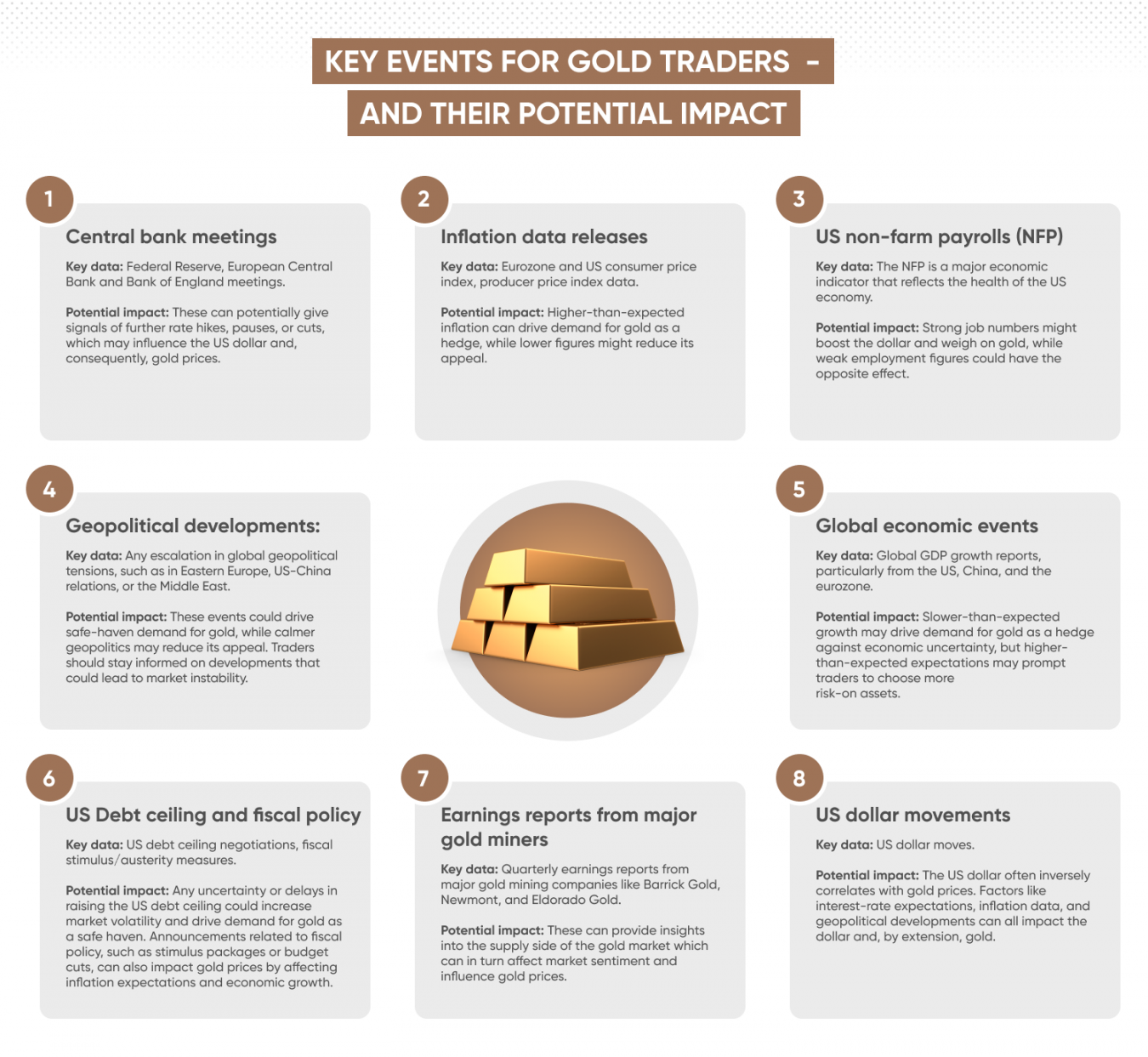Turning fundamental and technical trading strategies into gold trading
Find out how you can leverage fundamental and technical strategies in response to the dynamics driving gold.
Market of the Month: Gold trading strategies
Last week, we visualised the key potential drivers of gold in a chart focused on recent performance. Understanding the factors that can move gold prices is essential, but translating that knowledge into effective trading strategies is where the real potential can lie.
As a CFD trader, you have the choice of taking a position on both rising and falling gold prices, allowing you to adapt to a variety of market conditions. Here’s how you can leverage fundamental and technical strategies in response to the dynamics driving gold.
Fundamental strategies
Fundamental analysis involves looking at the broader economic factors that influence gold prices, such as inflation data, interest rates, and geopolitical events.
Interest rate sensitivity
Since gold price movement has often historically shown an inverse correlation to interest rates, you can monitor central bank announcements closely. For example, if the Federal Reserve signals a pause or cut in interest rates, you might consider a long position in gold CFDs, anticipating that lower rates could weaken the dollar and increase gold prices and vice versa.
Inflation hedging
When inflation data shows an uptick, gold typically gains appeal as a hedge and vice versa. In such scenarios, a strategy to go long on gold CFDs could be advantageous, as higher inflation expectations might drive up demand for gold. However, going long could also result in losses if inflation expectations don't materialise as anticipated or if other factors, such as a stronger US dollar or rising interest rates, exert downward pressure on gold prices.
Geopolitical events
Gold often rallies during times of geopolitical uncertainty. If tensions rise in key regions, taking a long position in gold CFDs could capitalise on the safe-haven demand. Conversely, if tensions ease, a short position might be beneficial as the market shifts back to riskier assets.

Golf price chart
Past performance is not a reliable indicator of future results.
Technical strategies
Technical analysis focuses on price charts, patterns, and indicators to predict potential future price movements. Here’s how you can apply technical strategies to gold CFDs:
Trend following
Identify and follow the trend using moving averages or trend lines. If gold is in an uptrend, consider using a trend-following strategy, such as buying on pullbacks or breakouts above resistance levels. Conversely, if gold is in a downtrend, look for potential opportunities to short the market.
Support and resistance levels
Monitor key support and resistance levels on gold’s price chart. If gold approaches a strong support level, you might consider going long, anticipating a bounce. If it nears a resistance level, potential shorting could be introduced, expecting the price to reverse.
Momentum indicators
Use indicators like the relative strength index (RSI) or moving average convergence divergence (MACD) to gauge momentum. If RSI indicates that gold is oversold, it might signal a buying opportunity. If it’s overbought, you could choose to short the market.
Breakout trading
Watch for price consolidations and breakouts from key levels. If gold breaks out of a consolidation pattern, like a triangle or a flag, you might enter a trade in the direction of the breakout, expecting a significant move. However, be aware that a breakout is not assured as false breakouts can occur, where the price momentarily moves beyond a key level only to reverse direction quickly, trapping traders in losing positions.
Risk management
Regardless of the strategy you choose, effective risk management is crucial. Here are the key points to bear in mind.
Set stop-loss orders: always set stop-loss orders to protect against unexpected market movements. This helps limit potential losses and manage risk more effectively.
Position sizing: carefully consider your position size relative to your account balance. Avoid over-leveraging, as it can amplify losses.
Stay informed: continuously monitor economic indicators, central bank announcements, and geopolitical events that can impact gold. Being informed allows you to adjust your strategies as conditions change.
By combining fundamental insights with technical analysis, you can develop a comprehensive approach to trading gold CFDs. Whether the market is bullish or bearish, these strategies offer you the tools to navigate the volatility and capitalise on opportunities in the gold market.
Event: UK consumer price index: 16 October, 6:00am UTC
Why it matters for gold: While the impact may be smaller than US CPI, higher-than-expected inflation in the UK could potentially drive demand for gold as a hedge, while lower figures might reduce its appeal.
Event: China GDP: 18 October, 2:00am UTC UTC
Why it matters for gold: China's GDP release can impact gold prices by potentially driving them lower if strong growth reduces the appeal of safe-haven assets, or potentially pushing them higher if weak growth raises economic concerns and boosts demand for gold as a safe haven.